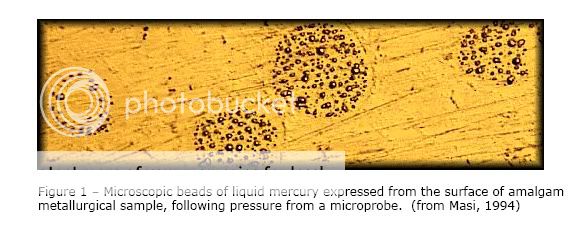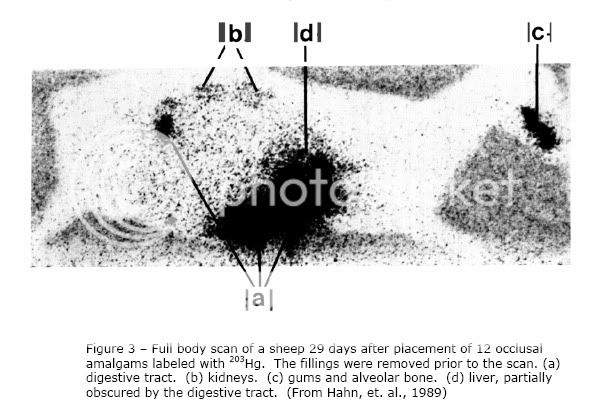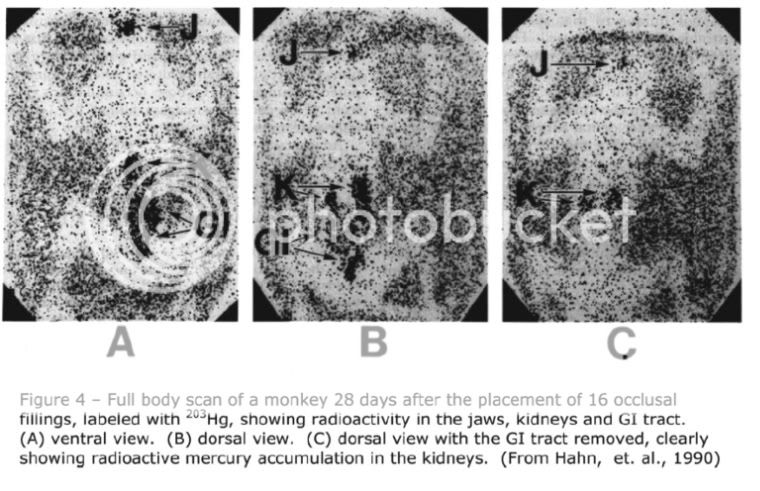I am neither a chemist nor omniscient but as I understand it the dental amalgam is a chemical compound of mercury and another metal so that the toxic mercury is extremely strongly chemically bound in the amalgam.
This is misleading and false. There is no chemical bond. Amalgam is a mixture of metals, and mercury vapour leaches 24/7 from amalgam fillings. This is
a scientifically indisputable fact.
This is what
Goodman and Gilman's, the "bible" of pharmacologics has to say on the issue:
"Mercury vapor also can be released from silver-amalgam dental restorations. In fact, this is the main source of mercury exposure to the general population" - Goodman & Gilman's, The Pharmacological Basis of Therapeutics
Here is a picture of mercury vapour being released from a tooth:
and a video from the
International Academy of Oral Medicine and Toxicology with further information:
[video=youtube;9ylnQ-T7oiA]http://www.youtube.com/watch?v=9ylnQ-T7oiA[/video]
And here are microscopic beads of liquid mercury forming from amalgam:
This is what happens when you put (radioactive-labelled) mercury in a sheeps mouth after only 1 month [Hahn, LJ; et al. Dental “silver” tooth fillings: a source of mercury exposure revealed by whole body scan and tissue analysis. FASEB J, 3:2641-6, 1989.]:
The mercury is found in the (a)
sheep's gastrointestinal tract, (b)
kidneys, the (c)
gum and alveolar bone of the jaws and (d)
liver. The mercury was also found (in lower concentrations) in the the sheep's
brain,
cerebrospinal fluid,
pituitary gland,
thyroid, and
adrenals.
The pro-amalgam dental associations complained that sheep are ruminants and do not chew like humans. So a repeat experiment was performed, this time with monkeys [Hahn, LJ; et al. Whole-Body Imaging of the Distribution of Mercury Released from Dental Fillings into Monkey Tissues. FASEB J. 4:3256-609 1990.]:
As you can see the results for monkeys were pretty much the same as for sheep. Remember this is only after 1 month of exposure. Imagine what a lifetime's exposure could do to a person.
Here is what the
United Nations Global Mercury Assessment 2002 has to say on the issue:
"New findings during the last decade indicate that toxic effects may be taking place at lower concentrations than previously thought, and potentially larger parts of the global population may be affected. As the mechanisms of subtle toxic effects – and proving whether such effects are taking place – are extremely complex issues, a complete understanding has so far not been reached on this very important question."
"For elemental mercury vapour, the most important source for the general population is dental amalgam."
"The main route of exposure for elemental mercury is by inhalation of the vapours. About 80 percent of inhaled vapours are absorbed by the lung tissues. This vapour also easily penetrates the blood-brain barrier and is a well-documented neurotoxicant."
"Neurological and behavioral disorders in humans have been observed following inhalation of elemental mercury vapour. Specific symptoms include tremors, emotional lability, insomnia, memory loss, neuromuscular changes, and headaches. In addition, there are effects on the kidney and thyroid.
persistent effects (tremor, cognitive deficits) have been observed in occupationally exposed subjects 10-30 years after cessation of exposure (Albers et al., 1998; Kishi et al., 1993; Mathiesen et al., 1999; Letz et al., 2000)."
"Self-reported memory disturbances, sleep disorders, anger, fatigue, and/or hand tremors were increased in workers chronically exposed to an estimated air concentration of 0.025 mg/m3 (approximately equal to urinary and blood mercury levels of about 25 μg/g and 10 μg/l) (Langworth et al., 1992)"
"Data from humans does not allow identification of lowest harmful or non-adverse exposure levels, especially in long-term exposure"
Here is what
Martindale, the complete drug reference has to say:
"Poisoning with liquid mercury or inorganic mercury salts has arisen from a variety of sources such as … dental materials"
"Chronic mercury poisoning may result from inhalation of mercury vapour … over prolonged periods. It is characterised by many symptoms including tremor, motor and sensory disturbances, mental deterioration, gastrointestinal symptoms, dermatitis, kidney damage, salivation and gingivitis."
"There has been considerable concern over the systemic absorption of mercury from dental amalgam, which typically contains between 40 and 70% of mercury."
"The kidneys are one of the primary sites for the accumulation of mercury in the body. All forms of mercury may be toxic to the kidney although the inorganic forms are the most nephrotoxic."
"The hazards associated with mercury generally outweigh any therapeutic benefit and its clinical use has largely been abandoned."
Here is what some of the world's foremost toxicologists have to say on the issue:
“The lowest exposure, in terms of urinary mercury secretion, that has been found to give rise to a demonstrable toxic effect has fallen from 30-50 μg/l till 10-25 μg/l. Accordingly, the safety margin that it was thought existed with respect to mercury exposure from amalgam has been erased.”
“The clinical studies of how mercury vapour influences the immune system show clearly that effects can be demonstrated down to dose levels corresponding to exposure to amalgam.” Prof. Maths Berlin (toxicologist)
“There is no safe level of mercury” - Prof. Lars Friberg (World Health Organization)
This is what the manufacturer's of amalgam have to say on it's safety:
In 1997, the amalgam manufacturers Dentsply-Caulk and Ivoclar-Vivadent, altered their Manufacturer’s Safety Data Sheets (MSDS) for Germany and California to include the
following adverse health effects from chronic inhalation and/or ingestion:
"tremor, fatigue, headaches, irritability, excitability, depression, insomnia, loss of memory, hallucinations, psychiatric disorders, mental deterioration and resentment of criticism, bronchitis, kidney failure, chest pain and palpitations, colitis, dermatitis, blood disorders, infertility and birth defects."
This is what the BDA (British Dental Association) has to say on the issue:
“Mercury is a toxic substance”
“… dental amalgam is not inert. Amalgam fillings release mercury vapour, especially when teeth are chewed on or brushed.”
“[Mercury] accumulates in certain organs - especially the kidneys but also in the brain, lungs, liver and gastrointestinal tract.”
“Whether amalgam can be called ‘safe’ is a matter for manufacturers of amalgam and for the Department of Health, and for the toxicologists and other scientists who advise them.”
“It is never possible to say categorically that anything is safe in all circumstances.”
"Research in the field is on-going and it is, of course, not ruled out in theory that evidence could one day come to light showing that amalgam is hazardous"
There is a substantial body of scientific literature documenting the release of mercury vapour from amalgam fillings. Just one example:
"Three case reports are presented … indicating daily uptake of Hg as high as 100 micrograms. There is a considerable variation between people; certain people have a high mercury uptake from their amalgam fillings." Barregard et al. People with high mercury uptake from their own dental amalgam fillings. Occup Environ Med. 1995 Feb;52(2):124-8.




